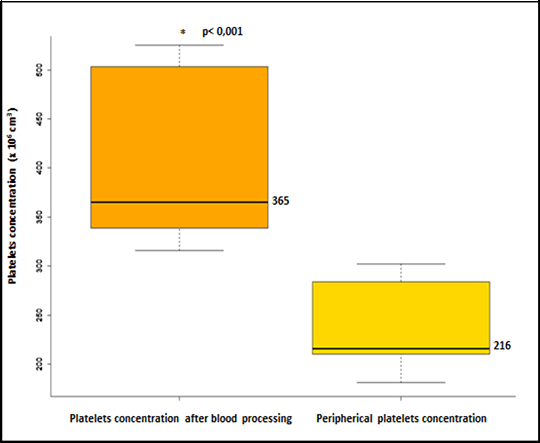“ Process of obtaining and description of autologous and generic platelet rich plasma”
Autologous platelet-rich plasma (PRP) is a blood derived product which is increasingly used in clinical practice. The curative properties of PRP are attributed to the fact that platelets are a physiological reservoir of growth factors (GFs), which play an active role in the tissue regeneration1. In the past decade, the development of PRP therapies to improve tissue repair has rapidly expanded in different medical fields and is used to treat diverse pathologies such as vasculitis, neuropathic and diabetic foot ulcers, tendinopathies, or osteoarthritis. Adoption of PRP technology led to commercialization of centrifuges/systems for manufacturing PRP at the bed-side; alternatively, PRP can be obtained by manual procedures performed in clean/aseptic areas. Yet different protocols lead to different PRP substances, and to reduce confusion for research and clinical purposes, PRPs have been classified into two main categories: leukocyte and platelet rich plasma (L-PRP), and pure platelet-rich plasma (P-PRP)2. The PRP, we plan to obtain, is classified in the literature as pure PRP with a moderate concentration of platelets (1-2.5) greater than the count in peripheral blood, in a volume of plasma, which is about one half of the volume of blood collected from the patients. The aim of this study is to standardize a PRP preparation, using a low-cost procedure. In order to obtain the autologous PRP, a volume of 9-30 ml of peripheral blood is collected from the patient in sterile 9 ml tubes containing 3.8% sodium citrate, as an anticoagulant. The tubes are centrifuged for 6 minutes at 1200 rpm to separate the different components according to their density. Blood was obtained from 12 healthy volunteers and immediately centrifuged to obtain packed red blood cells, buffy coat mainly containing leukocytes and PRP The platelet count was 1.685 + 0.12 (figure 2) times greater than in peripheral blood. The range was between1.5-1.9 times. Table 1: Complete blood count in (x10n/cm3).

We describe a blood processing protocol for obtaining an autologous and generic PRP, with a moderate concentration of platelets (almost doubling the concentration of platelets) This generic PRP can be used in a liquid or gel configuration, and presently it is examined as an investigational product for the treatment of tendinopathies and chronic leg ulcers. 1Andia I, Sanchez M, eta al. (2010) Expert Opin Biol Ther.10(10):1415-26//2. Dohan Ehrenfest DM, Rasmusson L, et al. (2009) Trends Biotechnol. 27(3), 158-67
|


 Figure 2 Peripheral blood platelets concentration and Neutr:neutrophils /lymph: lymphocytes/monoc: monocytes/Platel:platelets platelet concentration after blood processing
Figure 2 Peripheral blood platelets concentration and Neutr:neutrophils /lymph: lymphocytes/monoc: monocytes/Platel:platelets platelet concentration after blood processing